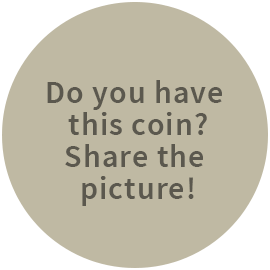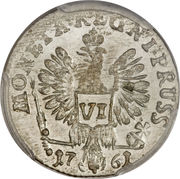Items from the Kingdom of Prussia
Do you want to take a photo with the camera or select an existing image?
The Kingdom of Prussia (German: Königreich Preußen) was a German kingdom that constituted the state of Prussia between 1701 and 1918. It was the driving force behind the unification of Germany in 1871 and was the leading state of the German Empire until its dissolution in 1918. Although it took its name from the region called Prussia, it was based in the Margraviate of Brandenburg, where its capital was Berlin. The kings of Prussia were from the House of Hohenzollern. Prussia was a great power from the time it became a kingdom, through its predecessor, Brandenburg-Prussia, which became a military power under Frederick William, known as "The Great Elector". Prussia continued its rise to power under the guidance of Frederick II, more commonly known as Frederick the Great, who was the third son of Frederick William I.[8] Frederick the Great was instrumental in starting the Seven Years' War, holding his own against Austria, Russia, France and Sweden and establishing Prussia's role in the German states, as well as establishing the country as a European great power. After the might of Prussia was revealed it was considered as a major power among the German states. Throughout the next hundred years Prussia went on to win many battles, and many wars. Because of its power, Prussia continuously tried to unify all the German states (excluding the German cantons in Switzerland) under its rule, and whether Austria would be included in such a unified German domain was an ongoing question. After the Napoleonic Wars led to the creation of the German Confederation, the issue of unifying the German states caused a number of revolutions throughout the German states, with all states wanting to have their own constitution. Attempts to create a federation remained unsuccessful and the German Confederation collapsed in 1866 when war ensued between its two most powerful member states, Prussia and Austria. The North German Confederation, which lasted from 1867 to 1871, created a closer union between the Prussian-aligned states while Austria and most of Southern Germany remained independent. The North German Confederation was seen as more of an alliance of military strength in the aftermath of the Austro-Prussian War but many of its laws were later used in the German Empire. The German Empire lasted from 1871 to 1918 with the successful unification of all the German states under Prussian hegemony; this was due to the defeat of Napoleon III in the Franco-Prussian War of 1870–71. The war united all the German states against a common enemy, and with the victory came an overwhelming wave of nationalism which changed the opinions of some of those who had been against unification. In 1871, Germany unified into a single country, minus Austria and Switzerland, with Prussia the dominant power. Prussia is considered the legal predecessor of the unified German Reich (1871–1945) and as such a direct ancestor of today's Federal Republic of Germany. The formal abolition of Prussia, carried out on 25 February 1947 by the fiat of the Allied Control Council, referred to an alleged tradition of the kingdom as a bearer of militarism and reaction, and made way for the current setup of the German states. However, the Free State of Prussia (Freistaat Preußen), which followed the abolition of the Kingdom of Prussia in the aftermath of World War I, was a major democratic force in Weimar Germany until the nationalist coup of 1932 known as the Preußenschlag. The Kingdom left a significant cultural legacy, today notably promoted by the Prussian Cultural Heritage Foundation (Stiftung Preußischer Kulturbesitz (SPK)), which has become one of the largest cultural organisations in the world.
Germany › German States › Prussia, Kingdom of › Breslau, Prussian bishopric of • Thaler
1748
Coins › Standard circulation coins
Gold (.986) • 17.5 g
KM# 223, Fr# 529, N# 277254
1748-1753
Coins › Standard circulation coins
Gold (.986) • 3.5 g
KM# 222, Fr# 530, Friedensburg# 2778, N# 365081
1753-1777
Coins › Standard circulation coins
Silver
KM# 225, Dav GT II# 2053, N# 277288
1796
Coins › Standard circulation coins
Silver
KM# 231, Friedensburg# 2790, N# 319378
1796
Coins › Standard circulation coins
Gold (.986) • 3.5 g
KM# 232, Fr# 531, N# 277292
Germany › German States › Prussia, Kingdom of › Eastern Prussia, Russian occupation of • Thaler (1759-1762)
1 Thaler = 180 Groschen = 540 Schilling
1759-1761
Coins › Standard circulation coins
Billon (.0625 silver) • 0.53 g • ⌀ 15.1 mm
KM# 286, Bit# 785, Neum# 366, Diakov# 679, N# 120532
1759-1761
Coins › Standard circulation coins
Billon (.156 silver) • 0.85 g • ⌀ 16 mm
KM# 287, C# 42, Schön DM# 36, Olding FR# 459, Schr# 1942, N# 120537
1759-1761
Coins › Standard circulation coins
Billon (.188 silver) • 1.46 g • ⌀ 18 mm
KM# 288, C# 43, Schön DM# 37, Olding FR# 458, Schr# 1932, N# 63783
1759-1761
Coins › Standard circulation coins
Billon (.288 silver) • 1.56 g • ⌀ 20 mm
KM# 289, C# 44a, Schön DM# 38, Olding FR# 456, Schr# 1915, N# 120538
1759-1761
Coins › Standard circulation coins
Silver (.500) • 5.49 g • ⌀ 28 mm
C# 46, Bit# 675, Diakov# 628, Olding FR# 453, KM# C290, N# 120531
1759-1762
Coins › Standard circulation coins
Silver • 2.83 g • ⌀ 23 mm
KM# B290, C# 45, Schön DM# 39, Olding FR# 454, Schr# 1882, N# 63782
1761
Coins › Standard circulation coins
Silver (.500) • 4.36 g • ⌀ 24 mm
C# 47b, N# 120536
1761
Coins › Standard circulation coins
Silver (.563) • 7.08 g • ⌀ 28 mm
C# 48, Bit# 806, N# 120535
Germany › German States › Prussia, Kingdom of • Unspecified currency
ND
Weights › Coin weights
Bronze • 10.74 g • ⌀ 20 mm
N# 170492
ND
Medals › Commemorative medals
Bronze • 2.4 g • ⌀ 19.5 mm
N# 59894
ND
Award medals › Military awards
Silver (.999) • 29 g • ⌀ 37 mm
N# 329166
ND
Award medals › Agricultural and industrial awards
Bronze • ⌀ 30 mm
N# 372807
ND
Award medals › Agricultural and industrial awards
Silver • 57.13 g • ⌀ 50 mm
N# 439125
ND
Award medals › Agricultural and industrial awards
Gold plated bronze • 87.7 g • ⌀ 60 mm
Heidemann# 921, N# 375911
ND
Utility items › Counter tokens
Copper • 3.44 g • ⌀ 24 mm
N# 238217
Germany › German States › Prussia, Kingdom of • Thaler
288 Pfennigs = 96 Gröschel = 72 Kreuzer = 36 Mariengroschen = 24 Groschen = 1 Thaler = ³⁄₁₇ Pistole • After 1857: 360 Pfennigs = 30 Silbergroschen = 1 Thaler
1701
Coins › Circulating commemorative coins: Coronation of Friedrich I
Silver • 28.98 g
KM# 14, Dav GT II# 2553A, Olding FR# 89a, Schr# 402, N# 304054
1701
Coins › Standard circulation coins
Silver • 29.14 g
KM# 15, Dav GT II# 2554, Müseler# 49.1/1, Schr# 405, N# 278650
1701
Coins › Standard circulation coins
Silver • 29.15 g
KM# 16, Dav GT II# 2554A, Schr# 406, Olding FR# 90b, Müseler# 49.1/2, N# 304509
1701
Coins › Standard circulation coins
Gold (.986) • 3.46 g
Olding FR# 91, KM# 18, Fr# 2296, N# 304156
1701
Coins › Circulating commemorative coins: Coronation at Konigsberg, January 18, 1701
Gold (.986) • 3.45 g
Olding FR# 114, KM# 17, Fr# 2297, N# 304157
1701
Coins › Standard circulation coins
Gold (.986) • 7 g • ⌀ 23 mm
Olding FR# 91, KM# 20, Schr# 7, Fr# 2296, N# 417676
Germany › German States › Prussia, Kingdom of • Unspecified currency
ND (1701)
Personality medals › Coronation and election medals
Silver • 126.18 g • ⌀ 66 mm
Steguweit RF# 33, Brock Pr# 386, Menadier S# 209, N# 432674
Germany › German States › Prussia, Kingdom of • Thaler
288 Pfennigs = 96 Gröschel = 72 Kreuzer = 36 Mariengroschen = 24 Groschen = 1 Thaler = ³⁄₁₇ Pistole • After 1857: 360 Pfennigs = 30 Silbergroschen = 1 Thaler
1701-1703
Coins › Standard circulation coins
Silver (.750) • 17.32 g • ⌀ 36 mm
KM# 13, Dav SG# 291, N# 310313
1701-1709
Coins › Standard circulation coins
Silver (.750) • 17.32 g • ⌀ 36 mm
KM# 12, Dav SG# 286, N# 304526
1701-1710
Coins › Standard circulation coins
Billon (.0729 silver) • 0.7 g • ⌀ 15.9 mm
Olding FR# 70, KM# 6, Schön DM# 7, Neum# 22, N# 121195
1701-1711
Coins › Standard circulation coins
Silver • 8.56 g
KM# 11, N# 304536
1701-1713
Coins › Standard circulation coins
Billon (.437 silver) • 3.5 g • ⌀ 25.5 mm
KM# 7, Schön DM# 8, Schr# 164-, N# 128516
1701-1713
Coins › Standard circulation coins
Billon (.438 silver) • 3.46 g • ⌀ 25.8 mm
KM# 8, Schr# 190 - 214, Schön DM# 8, Neum# 9, N# 78657
1702
Coins › Standard circulation coins
Silver (.6406) • 6.32 g • ⌀ 27 mm
Olding FR# 65, KM# 22, Schr# 316, N# 310330
1702
Coins › Standard circulation coins
Silver • 17.03 g
Dav SG# 286, N# 304527
1702
Coins › Standard circulation coins
Silver • 29.29 g
Olding FR# 1a, KM# 25, Schr# 46, Dav GT II# 2555A, N# 295674
1702
Coins › Standard circulation coins
Silver • 29.26 g
Olding FR# 1a, KM# 24, Schr# 46, Dav GT II# 2555, N# 304340
1702
Coins › Standard circulation coins
Silver • 29.12 g
KM# 27, Dav GT II# 2557, Schr# 49, N# 304510
1702-1706
Coins › Standard circulation coins
Gold (.986) • 3.5 g
KM# 28, Fr# 2309, Schr# 27, N# 264843
1702-1709
Coins › Standard circulation coins
Billon (.375 silver) • 3.49 g • ⌀ 25 mm
KM# 21, Schön DM# 10, Neum# 19, Schr# 318 - 325, N# 61156
1703
Coins › Standard circulation coins
Billon (.125 silver) • 0.3 g • ⌀ 13 mm
KM# 29, Schön DM# 3, Schr# 313, N# 127867
1703
Coins › Standard circulation coins
Billon (.125 silver) • 0.3 g • ⌀ 13 mm
KM# 30, Schön DM# 3, Schr# 314-315, N# 127868
1703
Coins › Standard circulation coins
Billon (.125 silver) • 0.44 g • ⌀ 13 mm
KM# 31, N# 310322
1703
Coins › Standard circulation coins
Billon (.125 silver) • 0.22 g • ⌀ 15 mm
Olding FR# 58, KM# 32, N# 436241
1703
Coins › Standard circulation coins
Billon (.250 silver) • 1.63 g • ⌀ 19 mm
Olding FR# 68, KM# 40, Schr# 349-50, N# 310331
The Numista referees for coins of this issuer are escoins and silvergeek.
The Numista referee for exonumia of this issuer is apuking.
An item is missing from the catalogue? Add it yourself!

































































































